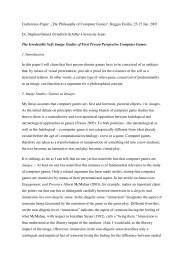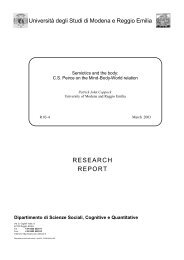Playing Dress-Up: Costumes, roleplay and imagination
Playing Dress-Up: Costumes, roleplay and imagination
Playing Dress-Up: Costumes, roleplay and imagination
You also want an ePaper? Increase the reach of your titles
YUMPU automatically turns print PDFs into web optimized ePapers that Google loves.
<strong>Playing</strong> <strong>Dress</strong>-<strong>Up</strong> Ludica<br />
In terms of play, I was an avid collector of dollhouse miniatures, Barbies, etc. I liked all the<br />
typical girl stuff (<strong>and</strong> had a lot of it). I actually played with it until an embarrassingly late age.<br />
I also liked to play make-believe <strong>and</strong> dress-up. Being the oldest, <strong>and</strong> having read far too many<br />
Louisa May Alcott stories, I liked to get my siblings dressed up <strong>and</strong> acting out plays whenever<br />
possible. Later, I caught the filmmaking bug <strong>and</strong> made them act in front of the camera.<br />
Digital <strong>Dress</strong>-<strong>Up</strong><br />
In the digital sphere, dress-up is a rapidly exp<strong>and</strong>ing play genre, but one which appears to be understudied.<br />
In our literature search, we were able to find very little about the role of dress-up in digital play,<br />
with the notable exception was T.L. Taylor’s foundational paper “Multiple Pleasures: Women <strong>and</strong> Online<br />
Gaming” (2003A) in which she suggests a more complex analysis of women in gaming than simply the<br />
“pink games” approach. Although the average participation in role-playing MMOG’s is estimated to<br />
remain at about 10%-20% female, Taylor points out that many women play these games despite their<br />
design, which often actively disenfranchises the female player. (Taylor 2003A, p.22) Taylor’s emphasis<br />
that the nuance of player roles, which are dictated in large-part by the “putting on of a character class”<br />
provides an opportunity for complex social interactions in which players strategically organize around<br />
their strengths <strong>and</strong> weaknesses. While many women opt for warrior or battle-oriented roles, others<br />
choices that allow for healing or spell-casting, or non-combat skills such as tailoring <strong>and</strong> herb gathering,<br />
provide women with the opportunity explore roles <strong>and</strong> experiment with a range of personality types<br />
within a context of social interdependency. These roles, which allow players to take on not only a “class”<br />
or profession, but also a “race,” such as elf, gnome, dwarf, or human, provide players with a costume<br />
which they can inhabit as they explore different aspects of their personalities. In the same way that a<br />
costume ball, Mardi Gras, or Burning Man gives players a way to explore different aspects of their<br />
personalities, these opportunities afford freedom to step out of stereotyped roles. Although it is clear that<br />
this is not a singularly female pleasure, women can <strong>and</strong> do experience distinct pleasures from it. Indeed,<br />
women who may be reticent to appear powerful in real-life may find themselves becoming more assertive<br />
<strong>and</strong> bold in the context of a game. (Taylor 2003A) Interestingly, men who suffer from shyness <strong>and</strong> social<br />
phobias can also find online games highly empowering in this regard. (Pearce 2006B)<br />
Taylor highlights some specific pleasures that female gamers identified in her study, <strong>and</strong> a number of<br />
these are relevant to dress-up play. (Taylor 2003A) Many of these qualities are supported by author<br />
Pearce’s ethnographic research (Pearce 2006B) in online games <strong>and</strong> seem to transcend specific games or<br />
genres. We elaborate on these here in terms of dress-up play:<br />
• Community <strong>and</strong> socialization: Pearce’s research supported Taylor’s findings that female players<br />
enjoy not only the “chat” aspect of socializing, but also the more instrumental aspects of social<br />
interaction, such as raid planning (in more formal, goal-oriented games such as EverQuest <strong>and</strong><br />
World of Warcraft) <strong>and</strong> activities around organizing events <strong>and</strong> communities (There.com, Uru).<br />
In addition, creativity <strong>and</strong> commerce was also a strong motivation. Women are among the top<br />
designers, especially of fashion, in the open-ended metaverses Second Life <strong>and</strong> There.com <strong>and</strong><br />
Pearce’s findings suggest that motivation for creative production is highly social. (Pearce, 2006A)<br />
• Identity Play “MMORPGs give the user (in varying degrees) an opportunity to engage in various<br />
identity performances <strong>and</strong> corresponding forms of play. Both because of the explicit nature of the<br />
space (role play) <strong>and</strong> the engagement with avatars, users can construct identities which may or<br />
may not correlate to their offline persona…Through the early decisions players make about their<br />
race <strong>and</strong> class they begin to fashion of themselves unique identities in the gamespace.” (Taylor<br />
2003, p. 27) <strong>Costumes</strong>, garb, attire, gear, fashion—in short, dress-up—provide players with a<br />
means to “put on” these identities <strong>and</strong> explore the avenues they open. In Second Life a single<br />
player can have many avatars, allowing exploration of diverse facets of his or her personality. It<br />
Philosophy of Computer Games 2007 Page 15






